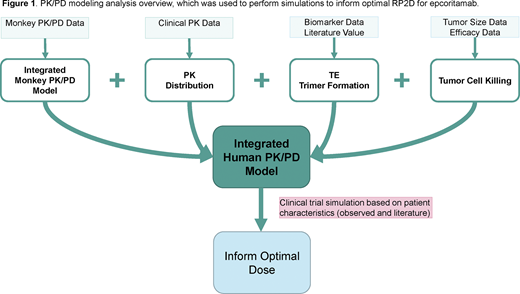Introduction: Epcoritamab (DuoBody-CD3×CD20) is a subcutaneously administered bispecific antibody (bsAb) that simultaneously binds to CD3 on T cells and CD20 on malignant B cells, resulting in T-cell activation and expansion and selective T-cell-mediated killing of CD20+ cells. Target engagement (TE) and crosslinking of CD3 and CD20 (trimer formation) lead to activation and expansion of T cells, which in turn leads to tumor cell killing and is the first step driving the pharmacology of epcoritamab. Hence, the optimal clinical dose of epcoritamab can be informed by TE and trimer formation. Unlike typical monoclonal antibodies, bsAbs exhibit a hook effect in which trimer formation is impaired at high drug concentrations. Therefore, targeting complete receptor occupancy can lead to suboptimal trimer formation and clinical efficacy; instead, the aim should be to identify epcoritamab concentrations that result in maximal trimer formation. Epcoritamab is currently being investigated in an ongoing, open-label, multi-center, first-in-human trial in patients with relapsed/refractory B-cell non-Hodgkin lymphoma (NCT03625037). Endpoints include safety and identification of RP2D and pharmacokinetic/pharmacodynamic (PK/PD) analyses. Here, we present our approach for recommending the RP2D for epcoritamab based on a novel PK/PD model that predicts trimer formation.
Methods: A semi-mechanistic PK/PD model was developed to quantitatively describe biodistribution of epcoritamab, trimer formation, and tumor response (Figure 1). This model makes use of preclinical data from cynomolgus monkeys, clinical PK/PD data, patient biomarker data, patient tumor characteristics, and response data. The model incorporates a minimal physiological-based PK model to predict epcoritamab concentration in tumors. The model also considers T- and B-cell dynamics, expression of CD3 and CD20 on these cells, and dynamic binding of epcoritamab to CD3 and CD20, as well as levels of trimer formation. Clinical trial simulations were performed using the PK/PD model, incorporating individual variability in key parameters, to predict the extent of trimer formation and tumor response in patients with diffuse large B-cell lymphoma (DLBCL) and follicular lymphoma (FL). Variability in model parameters was based on either interindividual variability observed in the first-in-human trial or literature values.
Results: The population PK/PD model was able to describe epcoritamab concentration-time profiles across doses (range: 0.0128-60 mg). Epcoritamab exhibited slow absorption, with Tmax of 2.8 days, a terminal half-life of 8.67 days, and target-mediated disposition (TMD). The model predicted the saturation of TMD to occur at dose levels ≥48 mg, indicating engagement and saturation of CD3 and CD20 in blood. In addition, the model was able to describe the exposure-response relationship observed in the clinic.
Clinical trial simulations using the PK/PD model demonstrated that a 48-mg dose can achieve optimal trimer formation and clinical response in both FL and DLBCL. An exposure-adverse event analysis showed a flat relationship between epcoritamab exposure and risk of cytokine release syndrome (CRS) in the dose range evaluated. Based on these findings, 48 mg was identified as the potential RP2D for epcoritamab.
Conclusions: For bsAbs such as epcoritamab, the optimal dose is one that leads to maximum trimer formation; hence, traditional PK modeling methodologies and exposure-response analyses are not adequate to guide RP2D selection. To overcome these limitations, we have developed a novel, semi-mechanistic PK/PD model incorporating preclinical, clinical, and patient biomarker data that identified the optimal dose for epcoritamab. This PK/PD model represents a novel approach and provides a general framework that can be applied to other CD3 bsAbs.
Li:Genmab: Current Employment. Hiemstra:Genmab: Current Employment, Current equity holder in publicly-traded company. Chiu:Genmab: Current Employment. Oliveri:Genmab: Current Employment, Current equity holder in publicly-traded company. DeMarco:Genmab: Current Employment, Current equity holder in publicly-traded company. Salcedo:Genmab: Current Employment. Lihme Egerod:Genmab: Current Employment. Gupta:Genmab: Current Employment.
Epcoritamab is an investigational agent undergoing evaluation in patients with relapsed/refractory B-cell non-Hodgkin lymphoma.
Author notes
Asterisk with author names denotes non-ASH members.


